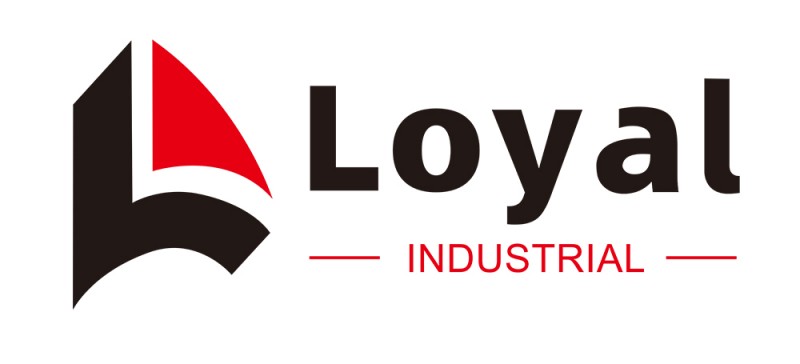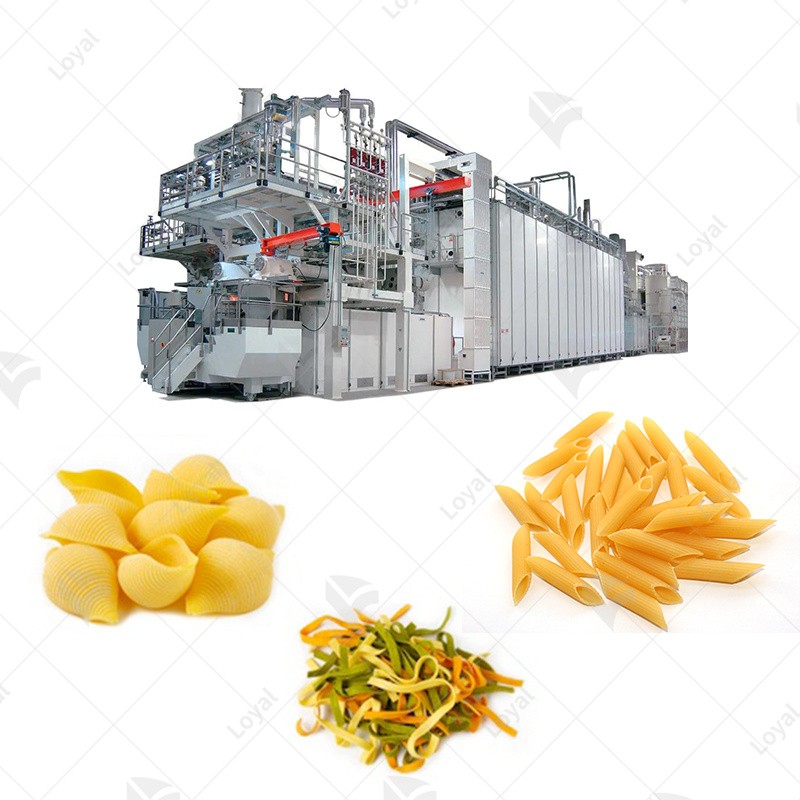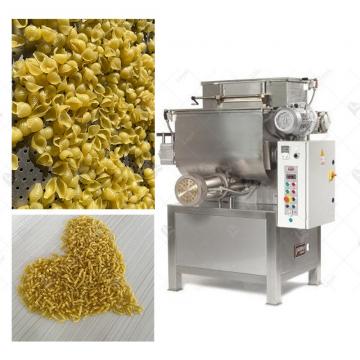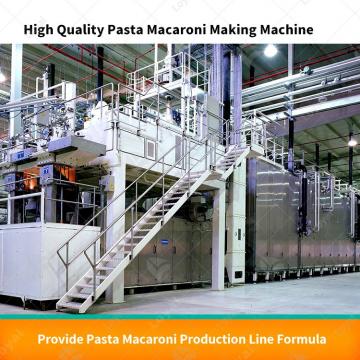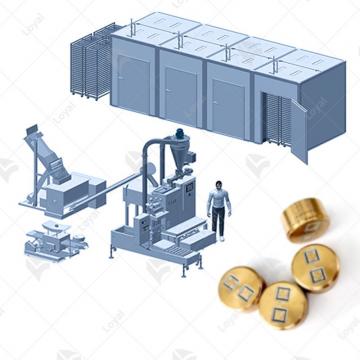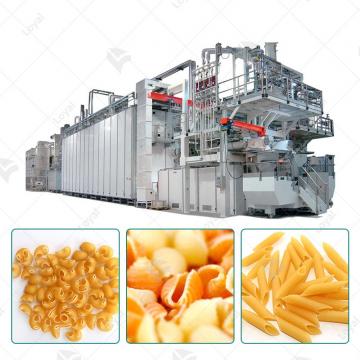Unprecedented Speed and Quality: Fully Automated Pasta Production Solutions
Unprecedented Speed and Quality: Fully Automated Pasta Production Solutions
Introduction
In a world driven by efficiency and excellence, the demand for advanced solutions in pasta production has never been higher. The significance of fully automated pasta production is evident as businesses strive to meet consumer expectations for speed and quality. As we delve into the transformative landscape of pasta manufacturing, the need for unprecedented speed and quality takes center stage, reshaping the competitive dynamics of the industry.The Macaroni Pasta Production Line technology of Shandong Luoya Industrial Co., Ltd. has introduced advanced technologies from HEMAKS and Capitanio.
Setting the stage, we unveil the advanced technology that underpins these fully automated solutions. Technology becomes the driving force behind achieving unparalleled speed and maintaining exceptional quality throughout the pasta production process.

Technological Advancements in Fully Automated Pasta Production
The journey towards unprecedented speed and quality in pasta production began with the evolution of automated machinery. Over the years, technological advancements have shaped the landscape, with automated systems evolving from basic mechanisms to sophisticated solutions. The integration of cutting-edge technology has allowed manufacturers to streamline processes, reduce manual intervention, and lay the foundation for the fully automated pasta production we witness today.
Key Advancements:
Early automation milestones.
Technological breakthroughs leading to increased efficiency.
Evolutionary changes paving the way for fully automated solutions.
Fully automated pasta production solutions leverage smart features to optimize processes and ensure a seamless workflow. These features encompass a range of functionalities, from intelligent monitoring to adaptive adjustments, contributing to both speed and quality. Smart automation is not merely about replacing manual tasks but enhancing every aspect of pasta production through data-driven decision-making and real-time adjustments.
Smart Features Highlights:
Intelligent monitoring for precision.
Adaptive adjustments to varying conditions.
Data-driven decision-making for enhanced efficiency.
At the forefront of technological innovation are robotics and artificial intelligence (AI), revolutionizing the pasta production landscape. Robotics introduces precision and speed, handling tasks with dexterity, while AI brings cognitive capabilities, enabling machines to learn, adapt, and continuously improve. The synergy between robotics and AI in fully automated pasta production systems ensures a level of efficiency that was once unimaginable.
Role of Robotics and AI:
Precision and speed through robotics.
Cognitive capabilities and continuous improvement with AI.
Synergy for enhanced efficiency in pasta production.
Achieving Unprecedented Speed in Pasta Production
One of the key outcomes of adopting fully automated pasta production solutions is the significant increase in production capacity. Automated systems enable continuous processing, eliminating the constraints imposed by manual labor and traditional machinery. The speed at which these systems operate ensures a substantial boost in the overall output, meeting the ever-growing demand for pasta products in the market.
Boosting Production Capacity:
Continuous processing capabilities.
Elimination of bottlenecks for increased efficiency.
Meeting market demand with accelerated output.
Automation brings about a paradigm shift in pasta production by ensuring continuous processing and minimizing downtime. Unlike traditional methods that may encounter interruptions due to manual intervention or maintenance, fully automated systems operate seamlessly. The reduction in downtime contributes directly to the overall efficiency, allowing manufacturers to maximize the utilization of resources and time.
Seamless Operations:
Continuous processing for uninterrupted workflow.
Minimizing downtime through automated systems.
Maximizing resource utilization for enhanced efficiency.
The precision timing mechanisms integrated into fully automated pasta production systems play a pivotal role in achieving unprecedented speed without compromising on quality. Automated processes are synchronized with utmost accuracy, ensuring each step in pasta production is executed precisely. The result is a consistent quality assurance, where every pasta product meets the predefined standards.
Ensuring Quality through Precision:
Synchronized processes for precision timing.
Consistent quality assurance in every production cycle.
Meeting and surpassing predefined quality standards.
Enhancing Quality through Automation
Consistency in product quality is a hallmark of fully automated pasta production. These systems eliminate variations in the manufacturing process, ensuring that each pasta product maintains uniformity. The precision offered by automation translates into consistent texture, taste, and appearance, meeting the expectations of both consumers and industry standards.
Uniformity and Consistency:
Elimination of variations in the manufacturing process.
Ensuring uniform texture, taste, and appearance.
Meeting consumer expectations and industry standards.
Automated pasta production goes beyond maintaining consistency; it incorporates advanced quality control systems. These systems utilize sensors, cameras, and data analytics to monitor and evaluate every aspect of the production process in real-time. Any deviation from the defined quality parameters triggers immediate adjustments, ensuring that only products of the highest quality reach the market.

Real-time Quality Monitoring:
Utilizing sensors and cameras for continuous monitoring.
Data analytics for real-time evaluation.
Immediate adjustments to maintain the highest quality standards.
The emphasis on consistent quality and advanced quality control translates into enhanced customer satisfaction and increased market competitiveness. Brands that leverage fully automated pasta production not only meet consumer expectations but also position themselves as leaders in the market. Customer loyalty and positive brand perception become integral components of sustained success.
Building Brand Excellence:
Enhanced customer satisfaction through consistent quality.
Increased market competitiveness.
Positioning as industry leaders for sustained success.
Sustainability and Efficiency in Fully Automated Pasta Production
Sustainability takes center stage in fully automated pasta production, with a focus on energy-efficient practices. These systems are designed to optimize energy consumption, minimizing environmental impact and reducing operational costs. Energy-efficient features include intelligent power management, automated shutdown during idle periods, and the integration of renewable energy sources where applicable.
Optimizing Energy Consumption:
Intelligent power management for efficient operation.
Automated shutdown during idle periods to conserve energy.
Integration of renewable energy sources for sustainable production.
Fully automated pasta production contributes significantly to waste reduction and resource optimization. The precision and control offered by automation minimize material waste during the manufacturing process. Additionally, automated systems are designed to optimize the use of resources such as water and raw materials, ensuring minimal environmental impact and cost-effectiveness.
Minimizing Material Waste:
Precision control to minimize material waste.
Optimization of water and raw material usage.
Striking a balance between environmental responsibility and cost-effectiveness.
Future Trends and Innovations
The future of pasta production lies in the integration of emerging technologies that continue to shape the industry. Robotics, artificial intelligence, and machine learning are expected to play a more prominent role in fully automated systems, further enhancing efficiency, precision, and adaptability. Manufacturers embracing these technologies will be at the forefront of innovation.
Technological Advancements:
Increased integration of robotics and automation.
Growing role of artificial intelligence and machine learning.
Continuous pursuit of efficiency through technological innovation.
Adaptability is a key consideration for the evolution of fully automated pasta production. Future systems will be designed to be highly adaptive, capable of responding to changing market demands, product variations, and consumer preferences. The ability to reconfigure processes swiftly and efficiently will be a defining characteristic of next-generation automated pasta production.
Swift Response to Market Dynamics:
Highly adaptive systems for changing market demands.
Swift reconfiguration to accommodate product variations.
Meeting consumer preferences through efficient adaptability.
Conclusion
In conclusion, the journey through the exploration of fully automated pasta production solutions has highlighted the achievement of unprecedented speed and quality in the industry. From increased production capacity to precision timing, consistency in product quality, and sustainability practices, automation has revolutionized pasta manufacturing.
Key Achievements:
Increased production capacity for meeting market demand.
Precision timing contributing to consistent product quality.
Adoption of sustainable practices for long-term viability.

Looking ahead, the continuous evolution of pasta production technology is inevitable. The industry will witness further advancements in automation, sustainability, and adaptability. Manufacturers are encouraged to stay informed about technological innovations, positioning themselves for sustained success in the dynamic landscape of pasta production.
Embracing Ongoing Evolution:
Continuous advancements in automation, sustainability, and adaptability.
Staying informed about technological innovations for sustained success.
Embracing the ongoing evolution of pasta production technology.
